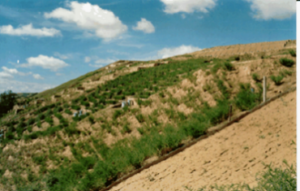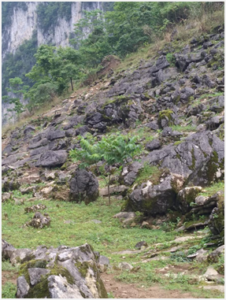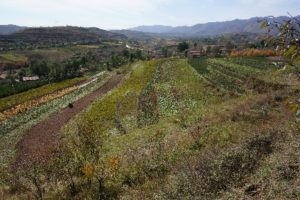Degradation is a key issue facing the world. United Nations Conference on Sustainable Development highlighted the role of ecosystem restoration in achieving sustainable development, and 2021-2030 has been dedicated as the United Nations Decade on Ecosystem Restoration (2021-2030). During this Decade UN Member States are encouraged to mainstream ecosystem restoration into policies and plans at the global, regional, national and local levels (UN, 2019). As the country with the largest population in the world, China has some of the most vulnerable ecosystems, and ecological conditions in 55% of China’s land area is vulnerable to degradation (NDRC, 2015). Over the past decades, rapid economic development has been achieved at the cost of ecosystem degradation and environmental pollution, which has also affected human wellbeing, particularly of those whose livelihoods are depended on the limited land and water resources. To reach Sustainable Development Goals and realize balanced development between economic growth, social wellbeing and environmental protection, the Chinese government defined a national mission in 2012: to establish an ecologically sustainable society, and China’s 13th five-year development plan (2016–2020) prioritized the establishment of an ecological civilization (EC) to improve the country’s ecological security. To ensure that EC is built on a scientific basis, the Ministry of Science and Technology of China has launched 37 National Key Research and Development Programs on “Ecological restoration and protection in the typical ecological vulnerable zones”; these programs were financed as the first batch of ecological restoration programs in China’s 13th five-year development plan.

Recent progress from one of the programs entitled “The methodology and indicator system for assessing ecological restoration technologies and evaluation of global ecosystem rehabilitation technologies” (grant number: 2016YFC0503700) indicated, that the major degradation issues in the vulnerable regions include soil and water erosion sandy desertification, Karst desertification and grassland degradation. The area stricken by soil erosion, sandy desertification and Karst desertification accounts for 31.06%, 22.19% and 7.26% of the total land area, respectively. To combat such degradation of natural resources, the Chinese government has implemented a number of ecological restoration projects since 2000, including one of the world’s largest, called Grain for Green project. Research results show that over the past 15 years (2000-2015), degradation in an overwhelming majority of the regions remained stable and unchanged (66.41% of total degraded area) or improved (22.06%); however, about 11.53% of the degraded areas showed a worsening trend. Areas that continue to degrade are most concentrated in the northwest and southwest regions where natural conditions are fragile and human activities are intensive; they are also the poorest regions of China. One of such examples is Guyuan district which is located in the upper stream of Jinghe watershed – one of the major attributes of the Yellow River, and is a key ecological functional zone for soil erosion conservation in China. Our research findings from an APN project (project reference number: CRRP2016-04MY-Zhen) indicate that land degradation is the most severe issue causing soil erosion and water loss, reducing land productivity, affecting local livelihood and water availability downstream, leaving the area one of the poorest in the country. Although several restoration programs have been implemented in the area, most of the land is still vulnerable to further degradation. The results revealed the demand for location-specific land management practices and underline the knowledge of agricultural management on an international scale. Meanwhile, the findings stress that for the regions with similar natural and socio-economic conditions, balanced development between ecological protection, economic growth and social wellbeing is a core to promote regional sustainable development.
The results revealed the demand for location-specific land management practices and underline the knowledge of agricultural management on an international scale.
The ultimate goal of ecological restoration is to promote an ecological civilization, by emphasizing harmony between humans and nature during development. Development and application of site-specific restoration technologies are pathways to achieve ecological civilization targets. Based on our studies we found that about 605 restoration technologies have been developed and used in China’s ecologically vulnerable regions since 2000, including 220 single technologies and 385 technology modes. Ecological restoration technologies (ERTs) contribute to achieving a selected number of ecological civilization targets (ECTs). Out of the 17 ECTs defined for the regions under study, the total contribution of ERTs to ECTs is about 27.2%, with contribution to economic targets ranking the highest, followed by ecological, social, and environmental targets. The ERTs contributed most to regions affected by soil erosion, followed by regions affected by Karst desertification and sandy desertification. Biological technology was the most used restoration technology. These findings are significant for reviewing the effectiveness of restoration technologies, and their ability to achieve ecological civilization goals.

The results imply that ecological restoration is a long run task. Degradation is a pervasive, systemic phenomenon and urgent and timely action is needed to avoid, reduce and reverse it. The designing, selection and application of restoration technologies must focus on the r specific degradation issue, phase and degree of degradation and its drivers, as well as local conditions including economic, cultural, policy and institutional settings. Technology needs assessment is vital for identifying suitable restoration measures, investigating potential areas for exporting and importing technologies. Nature-based restoration should be given priority, whenever and wherever possible, as the main solution for promoting the construction of an ecological civilization in China.

Reference
- United Nations (UN), 2019. United Nations Decade on Ecosystem Restoration (2021–2030). General Assembly, 69th plenary meeting, Seventy-third session, Agenda item 14. NY, USA.
- National Development and Reform Commission (NDRC) of China, 2015. The main functional area planning. People’s Publishing House, Beijing.